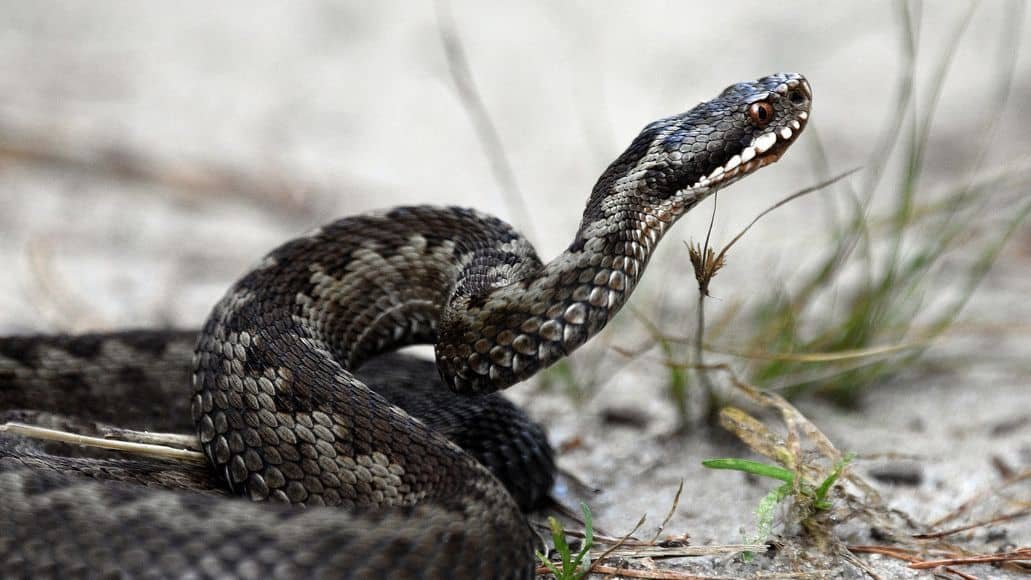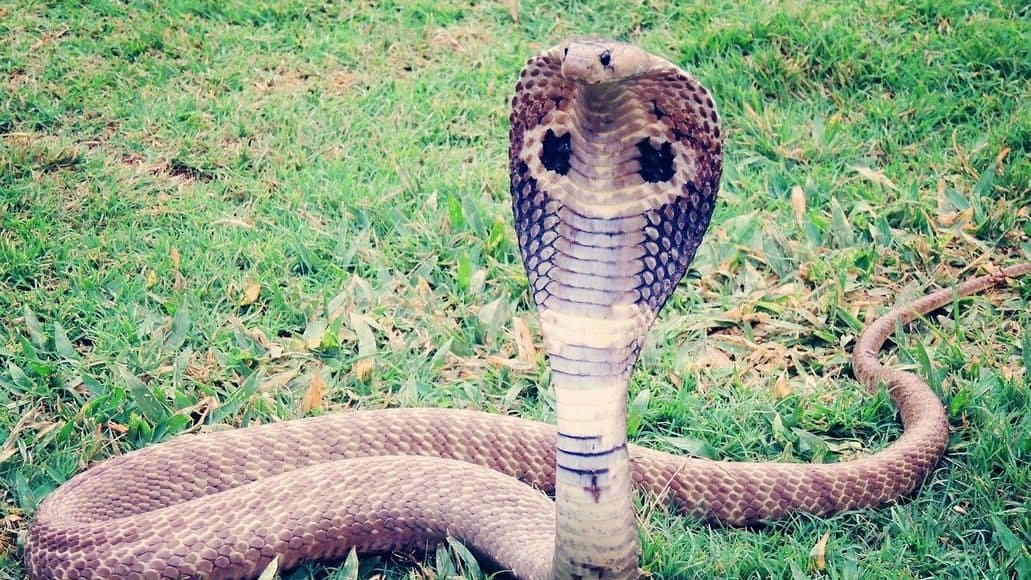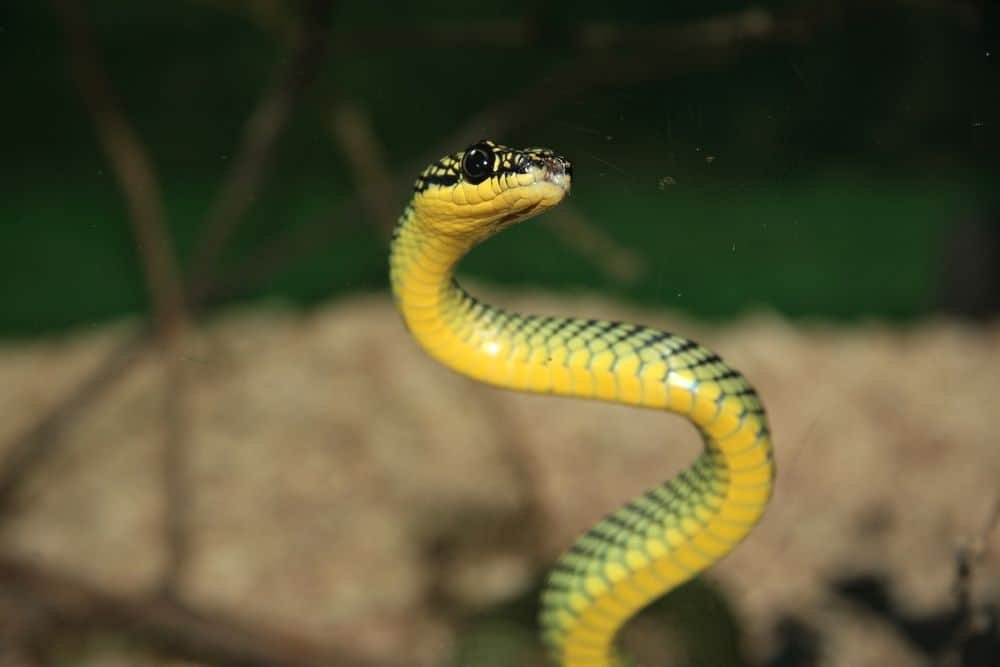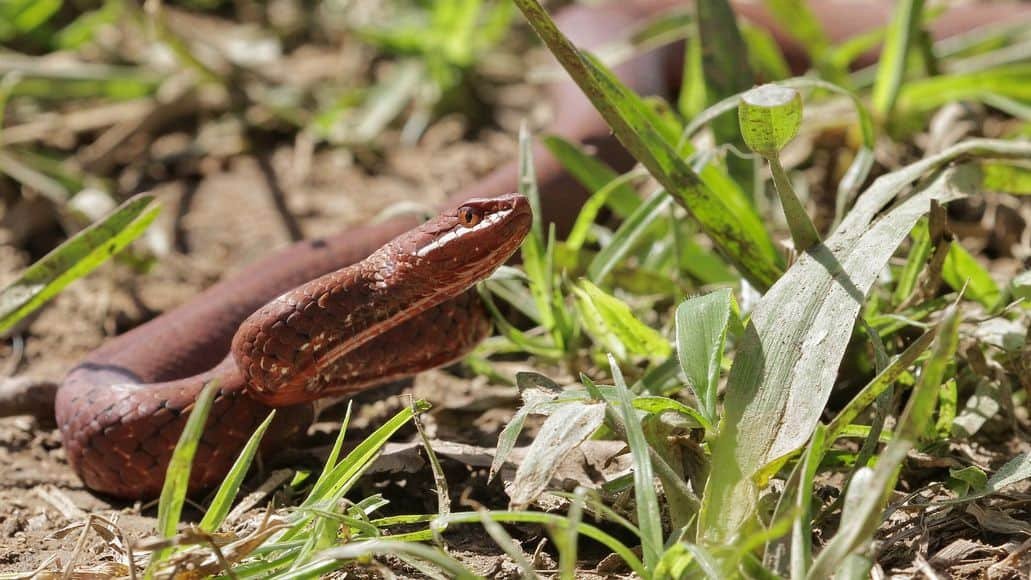
And that is completely understandable.
Stories abound, since ancient times, that make snakes out to be ferocious killing machines.
And the thought of a snake launching itself at you is terrifying.
It is only natural then to wonder how far a snake can jump.
But before we answer that question, we need to answer a more basic question: do snakes jump at all?
Keep reading for all the answers you need concerning snakes and their jumping abilities.
Table of Contents
Do Snakes Jump?
Snakes do not jump in the traditional sense of the word; they strike but remain on the ground. It can appear that they launch into the air, but they do not.
That said, there are some species of tree snakes that launch themselves from one tree and glide to the next. This is not technically jumping either, but it can be seen as such. We’ll get into all of this more below.
How Far Can A Snake Jump?

Snakes can strike roughly one-half of their body length comfortably. There are some exceptions and some nuance here, but generally, this is an accurate answer.
Snakes That Strike The Furthest Distance
The two snakes that can strike the furthest are rattlesnakes and King cobras. But they have this ability for different reasons.
Rattlesnakes
Rattlesnakes are serious predators and need to be extra muscular and fast striking to survive in the wild. As stated earlier, most snakes can strike about half of their body length, but rattlesnakes have been known to strike a full 2/3 of their body length.
This is not common in the animal kingdom, and it gives rattlesnakes an advantage in their habitat where much of the prey is very fast and alert.
To catch a rabbit in the wild, rattlesnakes need to be able to strike from a long distance, since rabbits have excellent sight and hearing and are always alert.
Because of the skill and speed of their prey in the wild, rattlesnakes have evolved an unparalleled striking distance and speed. This is one of the key attributes that has enabled these snakes to thrive in their environment for so long.
King Cobras

Rattlesnakes have an extra-long striking distance relative to their body size, because they have evolved the skill over thousands of years. King cobras, on the other hand, have an outrageous striking distance, not because of an evolutionary skill, but because they are massive snakes.
A king cobra can grow to be 18 feet long. This is huge. An 18-foot king cobra can strike over 9 feet from a coiled position, possibly longer if you take momentum into account.
Can you imagine being 9 feet away from a king cobra and still in the danger zone of its strike?
In addition to striking up to 9 feet, the king cobra also moves up to 2.98 meters per second squared. This gives you barely enough time to jump out of the way!
The Myth Of Jumping Snakes

There is a misconception that snakes can jump. There are no snakes that can jump off the ground.
There have been cartoons showing snakes bouncing around like a coiled spring, and some rumors about snakes jumping off the ground to bite you in the neck, but this is just nonsense.
When a snake strikes, it can appear to be a jumping movement, but the body never fully leaves the earth. It is not technically a jump.
Snakes are too long and heavy to jump off the ground. They would need a different design to pull this off.
The Evolution Of Snakes
At one point in their evolutionary journey, snakes could jump. They evolved from lizard-like creatures that had legs and could easily jump around.
When the lizards that today’s snakes evolved from began to burrow into the earth, they left their legs behind in the evolutionary trail. This led to the modern legless reptile we know and love as snakes.
Tree-Dwelling Jumping Snakes
Some of the jumping snake nonsense probably comes from a source of truth. There is a kind of snake that jumps. Sort of.
The Chrysopelea paradisi (paradise tree) snake is a tree-dwelling snake that moves from tree to tree by ‘’jumping’ and gliding.
It is not technically jumping, but it sure looks like jumping! You can see a video of these snakes flying here:
Since these snakes move through the air from tree to tree, they could be called jumping snakes. But this only serves to perpetuate the myth that snakes can jump.
It is more like flying, or gliding. But it is too enticing for us humans for a scary jumping snake to exist, so we keep the idea of this going. That said, a flying or gliding snake is still an incredibly unique snake.
Can Snakes Strike If They Are Not Coiled?
There seems to be a common misconception that snakes can only perform a strike if they are starting from a coiled position. This is not true. But being coiled is the way that snakes get the fastest and most accurate strikes.
The coiled position makes the lower half of the snake’s body smaller and harder for the threat to get to. It also serves as an anchor to keep the snake a safe distance from the threat with the lower half of its body, while the upper half, including the head and fangs, do the striking.
A snake can strike from any position, but if it is just laying on the ground, its strike will not go very far.
Normally a snake will rear up the top half of its body before it is ready to strike. It does not necessarily have to be coiled up.
However, most times you come across a snake that feels threatened, it will be coiled up already to keep itself safe from you.
This is probably why so many people think they need to be coiled to strike. This is just the way most striking snakes look when a careless human stumbles upon them.
Why Do Snakes Strike?

Snakes generally strike for two reasons:
- To defend themselves against predators
- To attack and disable their prey
Defense
If you come across a snake and you do not threaten it, you keep a safe distance, and you leave it alone, there is a very small chance it will strike at you.
More than likely, it wants you to be gone more than you want to get away from it.
A snake will only defend itself by striking if you threaten it. Snakes get an unfair reputation for being mean or dangerous, but they are only dangerous if you are in their territory messing with them.
Offense
Snakes strike to disable their prey so they can eat. Many snakes have strong venom which paralyzes, and sometimes kill, their prey Other snakes have milder venom which only temporarily stuns the prey.
A snake strikes its prey using the elements of speed and surprise, since many of the animals snakes prey on are very fast and alert to what is going on around them.
Do Snakes Jump And How Far: Final Thoughts
Now we know that snakes do not actually jump, although it can appear that way when they launch their upper body toward their prey to strike.
We also know that even the “flying” tree snakes are not really jumping. But what they do can be considered as jumping.
All that said, you do not need to worry about a snake jumping at you from anywhere. It is perhaps possible one can fall on top of you from a tree, but the chances of that happening are miniscule.
Leave a Reply